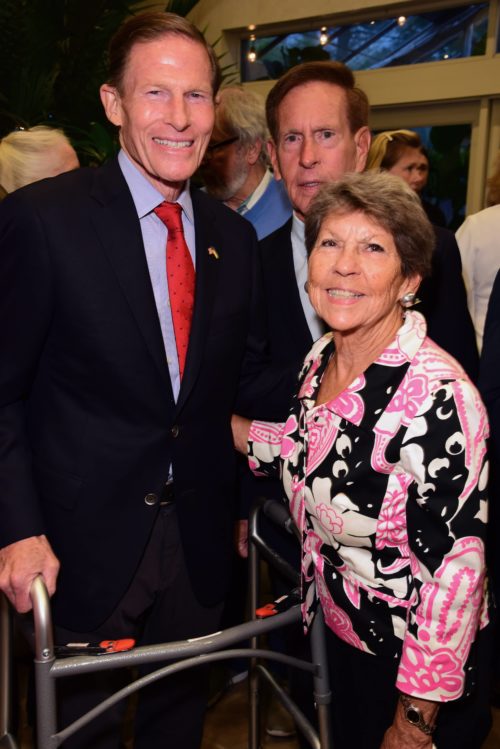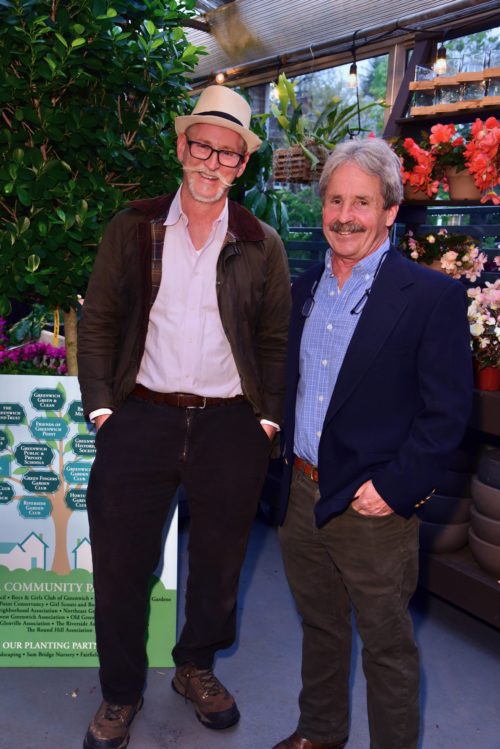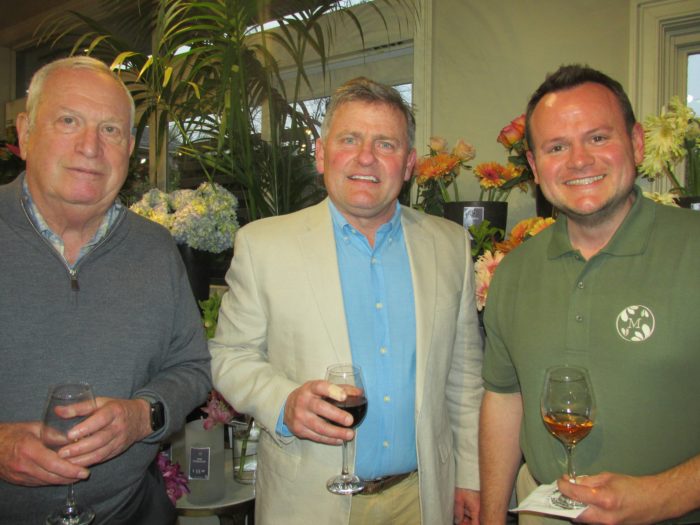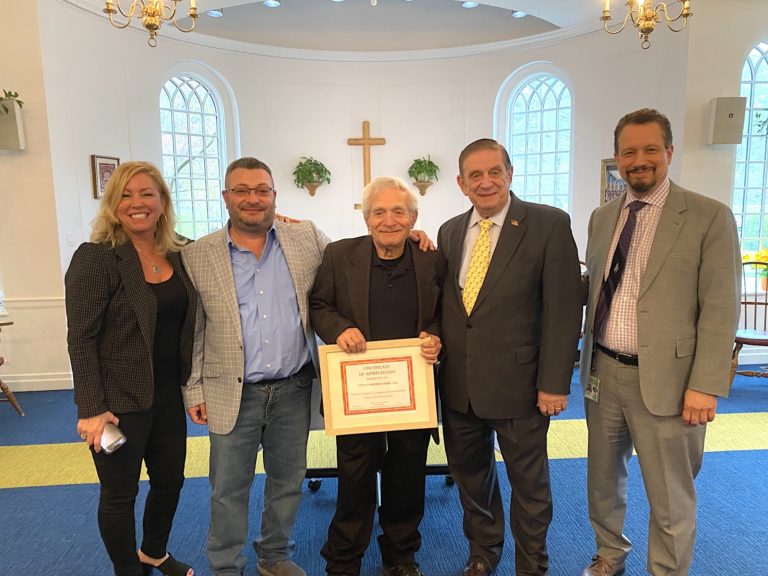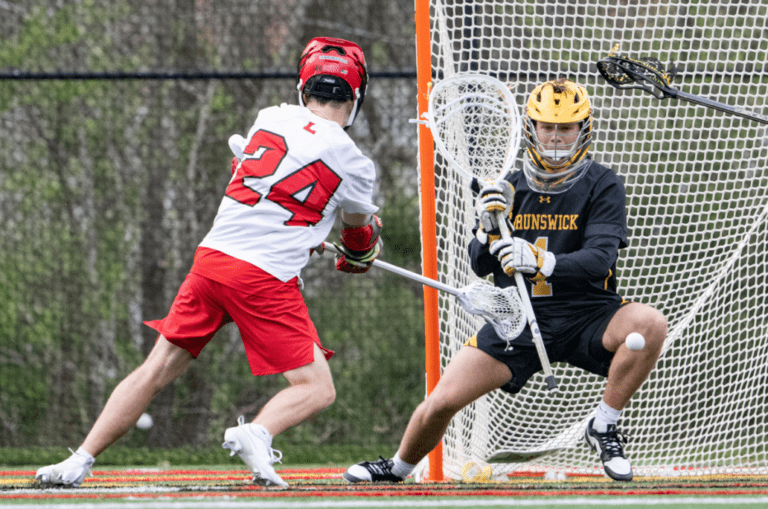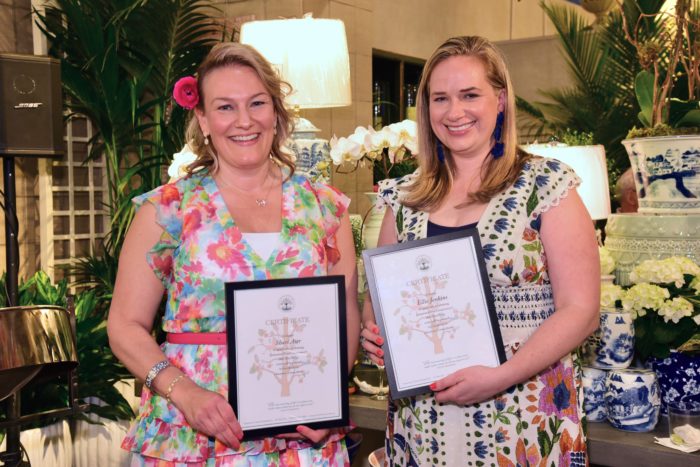
By Anne W. Semmes
They came in droves, the tree lovers, over 250, to celebrate the accomplishments of the now 16-year-old Greenwich Tree Conservancy (GTC), surrounded by explosions of color from a host of flowers laid out now for a twelfth year at McArdle’s Greenhouse. Guests were served sumptuous hors d’oeuvres from Happiness Is placed on those tree slice trays, with cocktails offered courtesy of Val’s Putnam Wines & Liquors.
GTC Chairman Peter Malkin and wife Isabel were not present in such a thick gathering but were represented by son-in-law Senator Richard Blumenthal who arrived with his walker having suffered injuries when a “fellow parade goer” tripped and fell upon him.
“I have the honor of representing Greenwich and the rest of Connecticut in the United States,” said Blumenthal, adding, “But more importantly, I am Peter and Isabel’s son-in-law. And so, I have to really mind what I say tonight! I’m so proud to be a Greenwich resident, to call Greenwich home. To have raised four children here with the kind of civic engagement and activism that the Greenwich Tree Conservancy demonstrates. So, please join me in a big round of applause for Urling Searle [GTC President], and JoAnn Messina [GTC Executive Director]. Thank you, JoAnn for your incredible leadership over so many years.”
Messina has presided over the planting of some 5,000 trees in Greenwich, along with the labelling of a thousand trees in the Town’s Arboretum. Add two more as Tree Party co-chairs, Shari Aser and Ellie Jenkins were recognized for their efforts by Searle with two trees to be planted in their names with their choice of where those trees are to be planted in town.

Aser stole a moment in her thanks to share the impact the Tree Conservancy has had on her life. “Exactly 12 years ago tonight,” she told, “I met my husband in this room, at this event.” “Clearly,” she added with a smile, “I had to co-chair the event eventually and plant many more trees… And I’m very glad [husband] Bill James asked me out after the event!”
“What a great night,” declared First Selectman Fred Camillo to the crowd. “It’s a week that we celebrate Arbor Day, daffodils, and Greenwich Tree Conservancy. And it shows that Greenwich is really a green town, and we treasure things like our trees.”
Worth adding here what Blumenthal also shared: “You know there’s an old saying that the sign of generosity is to plant a tree whose shade you will never enjoy. Looking around at this crowd, I think all of you are going to be around for the trees that we are planting – this is a very young crowd.”
So, perhaps the Town’s Tree Warden Dr. Greg Kramer who was present and thanked by our First Selectman for his tree-planting efforts might be the one to consult on tree choices to plant and where to plant. When asked by this reporter what might be his choice of ten trees to plant in Town, he came up with a list of “Top Ten” choices with full descriptions. See his choices listed separately here in the Sentinel!
Tree Warden Dr. Greg Kramer’s Top Ten Trees to Plant in Greenwich
1. Pawpaw; Asimina triloba. Planted in natural areas as part of various understory restoration plans. The small tree spreads via root runners and overtime will produce a grove. It can outcompete invasive plants and is not a preferred browse by deer. The fruit is relished by wildlife and the tree is the only larval host for the Zebra Tail Butterfly; Protographium marcellus.
2. Redbud; Cercis canadensis. Small native tree that is used for both restoration and beautification projects. The showy pink or white flowers provide an early nectar source for pollinating insects and arriving hummingbirds.
3. White Fringe tree; Chionanthus virginicus. A small understory tree that produces a showy bouquet of white fragrant flowers in the spring. Small purple fruit is produced on female trees in the fall that is relished by wildlife and serves to feed many birds during their migration south.
4. Persimmon; Diospyros virginiana. Medium sized tree that is used for restoration and soil erosion mitigation. Extremely hardy tree that produces small spring flowers visited by many pollinating insects. Females trees will produce fruit in the late fall that are edible and consumed my wildlife.
5. Carolina Silverbell; Halesia carolina. Small understory tree, used around parks and Town properties for beautification and insect pollination purposes. In spring white or pink showy bell-shaped flowers are produced.
6. American Holly; Ilex opaca. An evergreen medium to large growing tree used for various restoration projects. In spring the trees produce small flowers that many different insects visit. In fall female trees produce red fruit that provide a continuous food source for overwintering birds and animals.
7. Black Tupelo; Nyssa sylvatica. A large tree that is used in restoration and beautification projects. Can be planted in extremely wet soil. In fall, the female tree produces large crops of small blue fruit that is consumed by migrating birds. This species of tree produces some of the best fall color displays that change every year.
8. Cucumber Magnolia: Magnolia acuminate. A large growing magnolia that is used in restoration and beautification projects. The tree produces yellow/green flowers in the spring. The small fruit cone contains small red seeds that are used by migrating birds in the fall.
9. Willow Oak; Quercus phellos. A medium to large growing oak tree that has small leaves. Acorns are small and used by wildlife. The tree is used both in restoration projects and along the Town streetscape.
10. Bald Cypress; Taxodium distichum. A large growing, very adaptable deciduous conifer. The tree is used for soil stabilization and erosion control along waterways and pond edges that frequently flood. Additionally, the tree is planted in drier soils for its low maintenance requirements and beautiful fall color. Small cones mature in the fall and the seeds are consumed by wildlife.
